Color enhancement
Color enhancement is defined as an intensification of the brightness and vividness of colors in the external environment. During this experience, reds may seem “redder”, greens may seem “greener", and all colors will likely appear much more distinct, complex, and visually intense than they comparatively would be during everyday sober living.[1][2][3][4][5][6][7] At higher levels, this effect can sometimes result in seeing colors which are perceived as surreal or seemingly impossible.[3][4]
Color enhancement is often accompanied by other coinciding effects such as visual acuity enhancement and pattern recognition enhancement.[1][2] It is most commonly induced under the influence of mild dosages of psychedelic compounds, such as LSD, psilocybin, and mescaline. However, it can also occur to a lesser extent under the influence of certain stimulants and dissociatives such as MDMA, ketamine[8], or 3-MeO-PCP.
Image examples
| Caption | |
|---|---|
 | Showing differences by Chelsea Morgan |
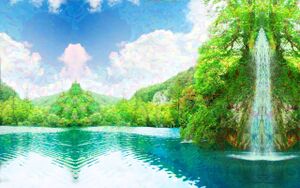 | Paradise island by Subsentience |
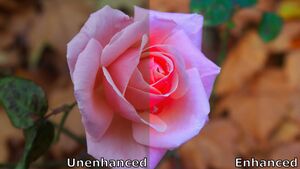 | Rose by Chelsea Morgan |
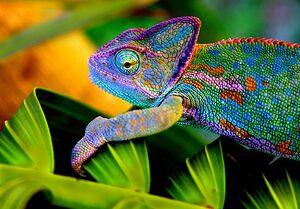 | Chameleon by Anonymous. |
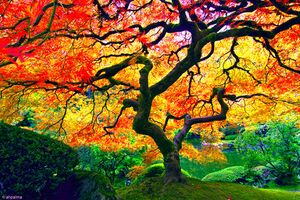 | Japanese Garden by Anonymous |
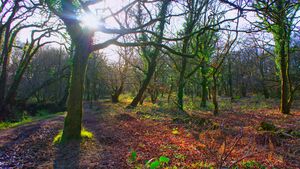 | The Woods by Chelsea Morgan |
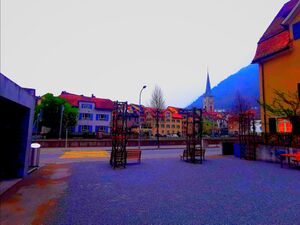 | Chur, Switzerland by Naps284 |
Psychoactive substances
Compounds within our psychoactive substance index which may cause this effect include:
- 1B-LSD
- 1P-ETH-LAD
- 1P-LSD
- 1V-LSD
- 1cP-AL-LAD
- 1cP-LSD
- 1cP-MiPLA
- 2,5-DMA
- 25B-NBOH
- 25B-NBOMe
- 25C-NBOH
- 25C-NBOMe
- 25D-NBOMe
- 25E-NBOH
- 25I-NBOH
- 25I-NBOMe
- 25N-NBOMe
- 2C-B
- 2C-B-FLY
- 2C-C
- 2C-D
- 2C-E
- 2C-H
- 2C-I
- 2C-P
- 2C-T
- 2C-T-2
- 2C-T-21
- 2C-T-7
- 3-MMC
- 3-MeO-PCE
- 3C-E
- 3C-P
- 4-AcO-DET
- 4-AcO-DMT
- 4-AcO-DiPT
- 4-AcO-MET
- 4-AcO-MiPT
- 4-FA
- 4-HO-DET
- 4-HO-DPT
- 4-HO-DiPT
- 4-HO-EPT
- 4-HO-MET
- 4-HO-MPT
- 4-HO-MiPT
- 5-Hydroxytryptophan
- 5-MeO-DALT
- 5-MeO-DiBF
- 5-MeO-DiPT
Experience reports
Annectdotal reports which describe this effect with our experience index include:
- Experience: 15mg 2C-B (oral) - A pleasant low-dose evening with Nexus
- Experience: 22mg 2C-B (oral) / 100ug 1P-LSD (sublingual) - My first time tripping alone (2 days in a row)
- Experience: 36mg 4-AcO-DiPT - Truly, one for the psychedelic animals among us
- Experience: 5-EAPB (60mg) + 2-FMA (20mg) + 4-AcO-DMT (10mg) - Emotional catharsis
- Experience:1000 Morning Glory seeds - Rediscovering the Self
- Experience:100ug 1P-LSD - A Fear and loathing into Bliss
- Experience:1050 µg 1cP-LSD - The matrix
- Experience:120mg - Garden of The Gods
- Experience:150mg MDMA + 20mg 2C-B - I designed it this way myself
- Experience:1mg 25c-NBOMe - Experiment in my room
- Experience:2 tabs DOB - My DOB Nightmare
- Experience:2.5g Syrian rue + 6g Mimosa Hostilis - Becoming God (my second experience with unity)
- Experience:225mg Pregabalin +Cannabis -Bliss and Serenity; a hedonistic evening
- Experience:225ug LSD + 9g cubensis - Galactic Melt and the Meverse
- Experience:250mg DXM - DXM Itch and Trip Report
- Experience:25mg 2C-B - Hard raving at home
- Experience:25mg 3-MeO-PCP - Enhanced film experience
- Experience:25mg Deschloroketamine - My first time orally dosing DCK
- Experience:2C-P (approx. 35mg) - Asymmetrical Terror and the Geometric Sea
- Experience:3 Grams of Mushrooms - Reset on my Life, Experiencing Satori and the Cosmic Perspective
- Experience:3-MeO-PCP - Extreme psychosis
- Experience:3.5g psilocybe cubensis - Relinquishing of Material Chains/Fear and Desolation
- Experience:300mg DXM + 25mg DMT + Cannabis - A crazy night
- Experience:300µg AL-LAD - Don't worry, because you're everyone!
- Experience:300µg LSD - Togetherness and the Silent Dusk
- Experience:337mg DMT fumarate - A Day With DMT
- Experience:3g mimosa / 3g syrian rue - Connecting with my body
- Experience:4-AcO-DMT + 200mg Pill
- Experience:4-HO-MiPT / A care free psychedelic getaway
- Experience:4.5g - The Grand Introduction to Beauty and Fear
- Experience:40mg - Brothermind and the Forest's Hand
- Experience:4x 200ug tabs - You do not need to understand
- Experience:5.3g psilocybe cubensis - Dimensional Circumstance and the Fabric of Understanding
- Experience:60mg 4-AcO-DMT Nonstop Quasi-Orgasmic Objectless Euphoria
- Experience:75mg 3-FMA - Perfect Blend of Euphoria and Functionality
- Experience:800 seeds LSA - My First Trip Ever
- Experience:A combination of DOC, 5-MAPB, 5-MeO-DMT, ETH-LAD, Cannabis, Pentedrone
- Experience:BK-2C-B - Various experiences
- Experience:Mushrooms and Snuff Films -- Trip Report (3.5 grams)
- Experience:Pregabalin (450mg, oral) + Methylphenidate (20mg, oral) - Gaba Flipping
- Experience:Psilocybin Mushroom (0.16 g, Oral) - Dosage Independent Intensity
- Experience:Unknown Dose DOC (Insufflated) - Overdosing and Terifying Ego Death
- Experience:Unknown dosage / 1 tab DOC - Psychedelia Turned Into Stimulant Psychosis
- Experience:~150mg MDA(oral) - a case of mistaken identity
See also
- Responsible use
- Subjective effects index
- Psychedelics - Subjective effects
- Dissociatives - Subjective effects
- Deliriants - Subjective effects
External links
References
- ↑ 1.0 1.1 Papoutsis, Ioannis; Nikolaou, Panagiota; Stefanidou, Maria; Spiliopoulou, Chara; Athanaselis, Sotiris (2014). "25B-NBOMe and its precursor 2C-B: modern trends and hidden dangers". Forensic Toxicology. 33 (1): 1–11. doi:10.1007/s11419-014-0242-9. ISSN 1860-8965.
- ↑ 2.0 2.1 Bersani, Francesco Saverio; Corazza, Ornella; Albano, Gabriella; Valeriani, Giuseppe; Santacroce, Rita; Bolzan Mariotti Posocco, Flaminia; Cinosi, Eduardo; Simonato, Pierluigi; Martinotti, Giovanni; Bersani, Giuseppe; Schifano, Fabrizio (2014). "25C-NBOMe: Preliminary Data on Pharmacology, Psychoactive Effects, and Toxicity of a New Potent and Dangerous Hallucinogenic Drug". BioMed Research International. 2014: 1–6. doi:10.1155/2014/734749. ISSN 2314-6133.
- ↑ 3.0 3.1 Hartman, Alan M.; Hollister, Leo E. (1963). "Effect of mescaline, lysergic acid diethylamide and psilocybin on color perception". Psychopharmacologia. 4 (6): 441–451. doi:10.1007/BF00403349. ISSN 0033-3158.
- ↑ 4.0 4.1 Kleinman, J. E.; Gillin, J. C.; Wyatt, R. J. (1977). "A Comparison of the Phenomenology of Hallucinogens and Schizophrenia From Some Autobiographical Accounts*". Schizophrenia Bulletin. 3 (4): 560–586. doi:10.1093/schbul/3.4.560. ISSN 0586-7614.
- ↑ Obreshkova, D., Kandilarov, I., Angelova, V. T., Iliev, Y., Atanasov, P., & Fotev, P. S. (2017). PHARMACO-TOXICOLOGICAL ASPECTS AND ANALYSIS OF PHENYLALKYLAMINE AND INDOLYLALKYLAMINE HALLUCINOGENS (REVIEW). PHARMACIA, 64(1), 41-42. http://bsphs.org/wp-content/uploads/2017/04/Angelova.pdf
- ↑ Abraham, Henry David (1983). "Visual Phenomenology of the LSD Flashback". Archives of General Psychiatry. 40 (8): 884. doi:10.1001/archpsyc.1983.01790070074009. ISSN 0003-990X.
- ↑ Baggott, M.J.; Coyle, J.R.; Erowid, E.; Erowid, F.; Robertson, L.C. (2011). "Abnormal visual experiences in individuals with histories of hallucinogen use: A web-based questionnaire". Drug and Alcohol Dependence. 114 (1): 61–67. doi:10.1016/j.drugalcdep.2010.09.006. ISSN 0376-8716.
- ↑ Dillon, P (2003). "Patterns of use and harms associated with non-medical ketamine use". Drug and Alcohol Dependence. 69 (1): 23–28. doi:10.1016/S0376-8716(02)00243-0. ISSN 0376-8716.